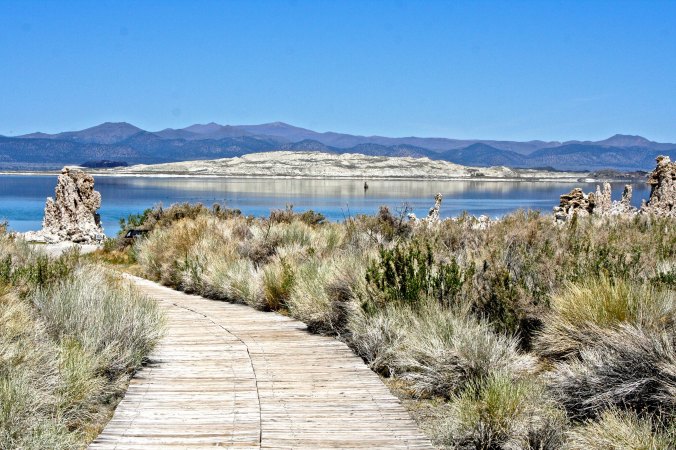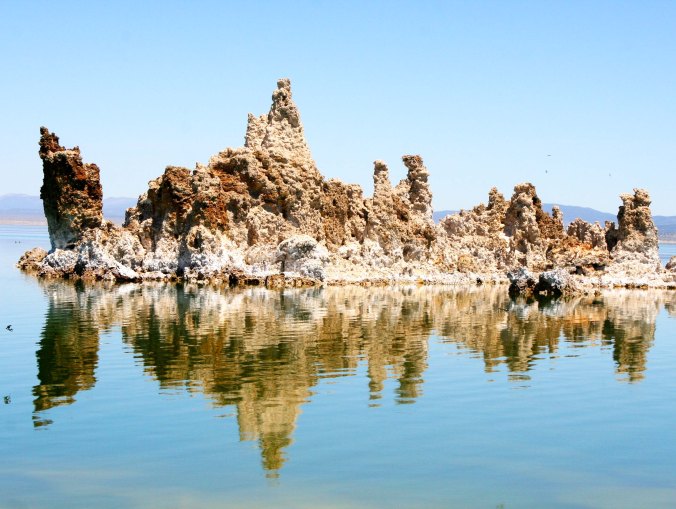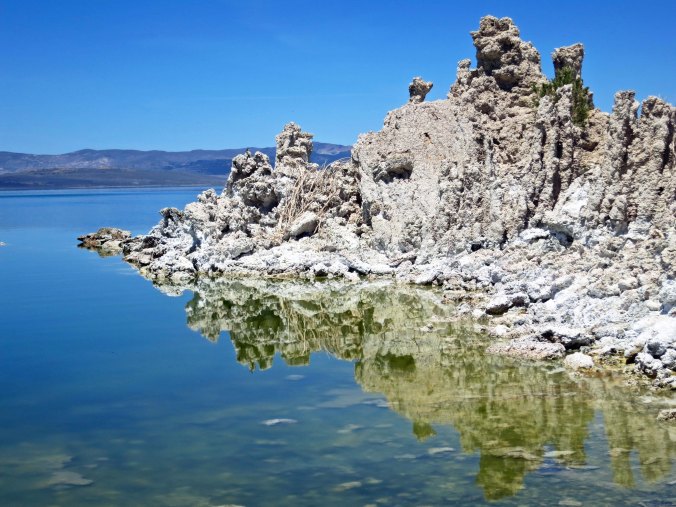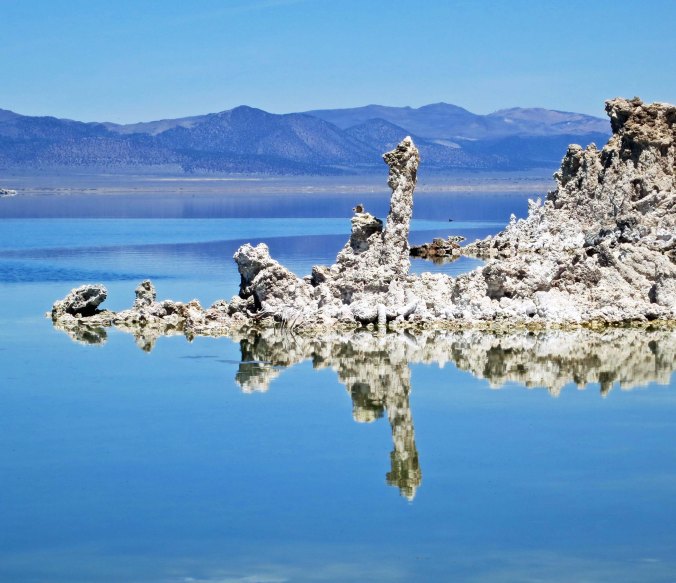To say the least, Mono Lake is a strange place. Some people even call it weird. Once upon a time, back when glaciers stretched across North America, it was part of a series of large lakes that covered much of modern-day Eastern California, Nevada and Utah, a region that is now primarily desert. Left behind as a remnant by retreating glaciers, Mono Lake is at least 760,000 years old and could be as old as three million years, making it one of the oldest lakes in North America.
What flows into Mono Lake, stays. There are no outlets. As a result, the lake is 2-3 times as salty as the ocean. Swimmers don’t have to worry about sinking. In fact the lake contains some 280 million tons of dissolved salts, which makes it even too salty for fish. An effort to introduce trout left them belly up on the surface, like the proverbial dead gold-fish destined for a close encounter with the family toilet.
Algae, brine shrimp, and alkali flies thrive in the water, however. The thumbnail-sized shrimp population is estimated to be somewhere between 4 and 6 trillion in the summer. Historically, the fly pupae served as a major source of food for the Kutzadika’a Indians. In fact, the name for the tribe means fly eater.
Today, both the flies and shrimp provide food for some two million birds that migrate through the area. One visitor, Wilson’s Phalarope, a tiny, fist-sized shorebird, takes advantage of the gourmet flies to double its weight and grow a new set of feathers before journeying 3000 miles to South America— a feat that is accomplished in three days of nonstop flying at speeds of over 40 miles per hour.
It isn’t flies, shrimp, birds, or salt water that Mono Lake is famous for, however. It’s tufa, the fantastical, fairy-like structures that grow in the lake and appeal to photographers from around the world. Calcium-rich water bubbling up from underwater springs combines with the lakes carbonate-rich waters in a chemical reaction to create the lime-based structures. Towers as high as 30 feet can be built under water through this process in a time span that may involve centuries.
The reason these towers are visible today is due to the unquenchable thirst of millions of people in Los Angeles. This thirst came close to destroying Mono Lake, as it did the Owens River and Owens Valley south of Mono Lake. Starting in 1941 the politically formidable Los Angeles Water and Power Company tapped into the streams flowing into Mono Lake and sent the water on a one-way, 330 mile journey south, reducing water in the lake from 4.3 million acre feet in 1941 to 2.1 million acre feet in 1982.
The United States Navy also posed a threat to Mono Lake by carrying out a series of under water explosion tests during the Cold War. The plaque at the site described these explosions as top-secret seismic tests. Whether the navy was searching for a way to predict earthquakes and tsunamis or cause them is the question. Fortunately, public pressure and concerns for public safety led to the navy abandoning its activities at Mono Lake in the late 50s/early 60s.
It was the growing environmental movement of the 70s and the Mono Lake Organization that eventually forced the Los Angeles Power and Water Company to reduce the amount of water it was exporting from Mono Lake’s tributaries. Today the lake is on the way to recovering its pre 1941 water levels (assuming it isn’t wiped out by global warming and drought). Mono Lake is found just north of Lee Vining off of Highway 395. Following Highway 120 west out of Lee Vining will take travelers into Yosemite National Park.

The Sierra Nevada Mountains provide a scenic backdrop in the west for Mono Lake. Highway 395 runs along the base of the foothills. Tufa can be seen emerging from the lake.

Following Highway 120 east off of Highway 395 will bring visitors to Mono Lake’s South Tufa Trail where the photos in this blog were taken. (Photo by Peggy Mekemson.)

Prior to Los Angeles tapping into the streams that provide water to Mono Lake, this tufa tower would have been underwater. Now it sits on dry land.

Reflections add extra character to this often photographed tufa island in Mono Lake— as they do in the next two photos. (Photo by Peggy Mekemson.)
NEXT BLOG: Having finished our desert series, Peggy and I return to Oregon and visit Oregon Caves National Monument.






I’ve heard of Mono Lake, but I’ve known only the name and nothing else.The Great Salt Lake is interesting, and the Salton Sea is weird, but this is something else entirely. I wonder if they ever tried tilapia there, which have survived in the Salton Sea. It may be that Mono Lake is even more saline.
The towers remind me of stalagtites and stalagmites in caves. The process of formation is different, of course, but the result’s amazingly similar in appearance.
I have to admit, that last photo is my favorite. Sometimes, a girl’s just got to have a little green with her rocks.
Where’s a nice green alien when you need one? 🙂 The comment on stalagmites and stalactites is right on. I had the same thought. And they are in my next blog where we visit Oregon Cave National Monument. Thanks for the lead in Linda. (grin) –Curt
Amazing facts I never knew. Great photos, a true insight into a beautiful and strange world.
Thanks Gerard. Mono Lake is one of those rare gems that sneaks up on you. –Curt
Very interesting to learn. I feel sorry for those trout though. 😉
I know, it’s tough being a fish sometimes… 😦
Fascinating post and beautiful photos. I wasn’t familiar with this place or its story.
It seems to me that California is placing demands on the water there that nature can’t meet. The water intensive agriculture, the booming water-consuming human population and the drought result in a demand that just can’t be met. It seems to me to be an unfolding ecological disaster.
It is Bill. I was involved in California water politics from the environmental side for a while. There are no easy solutions and lots of challenges— I suspect nature will force some very drastic changes. –Curt
Thanks Curt. What an amazing place. Fascinating and beautiful. I’d love to go there. Gorgeous photos.
Alison
And thank you Alison. Mono Lake is indeed special. –Curt
OK, Curt. I will allow you to blame me for the draw down on the water…but only because I like you. lol
You and Peggy sure get around. I have never been to Mono Lake nor to any of your other destinations near me. I have to turn to your good blog to “visit”…
…and an alien told there are 6 trillion and three shrimp. 🙂
I’d go with the alien. And I am glad to see they are communicating with you. LOL We are always glad to have you along on our trips. Koji.
On a more serious note, we stopped by Manzanar on our trip up 395. We thought of you and your family. –Curt
Here’s to us humans not doing anything more to spoil such a wonderful landscape and echo system. Great photos.
Thanks… and ditto. –Curt
Stunning photos. So interesting. Now, exactly WHY did the water co. want to destroy the lake?
LA Water and Power had one priority, D: obtaining water for LA. It wasn’t so much that they wanted to destroy the lake; it was more like they didn’t care. The company ran roughshod over anyone who got in the way. Water politics in California is nasty, as you may have noticed. State regulations now limit the amount of water they can take from the tributaries that feed Mono Lake. The plan is to return it to its original status. –Curt
What a uniquely beautiful place!
Peggy and I certainly find it so. It is like you’ve entered another world. –Curt
I love the strange complexity of our planet. Thanks for taking me to visit another weird, and in its own way beautiful, corner.
My pleasure, Hilary.
Curt, this place is fantastic! The photos that you and Peggy took are beautiful. It’s like a visit to Cappadocia’s fairy chimneys without even leaving the States. And I’m embarrassed to say I’d never heard of it. You’ve made my day. 🙂 ~Terri
Making your day and finding somewhere you haven’t been is no small thing, Terri. Glad you enjoyed it. And thanks. –Curt
My imagination goes absolutely wild when we are at Mono Lake! Peggy
Impossible not to… 🙂
How do you find these places? I have never heard of this place and the history is amazing..But then again I have not done 1/50th the exploring you and Peggy have done..I’m showing this place to my son, he will love these photos/story!
Sometimes we head out to find a specific place. 🙂 But most of them are on our way somewhere… Thanks Lynne. Hope your son enjoyed the photos. –Curt
I worry for Mono and all of California. I pray for them to get rain.
We live just across the border in Southern Oregon and share Northern California’s climate… and lack of water. Hopefully, next year will be better. Thanks for your concern. –Curt
What an interesting place! I’ve never heard of it. I’m looking it up.
Interesting, unusual and quite beautiful in its own unique way. –Curt